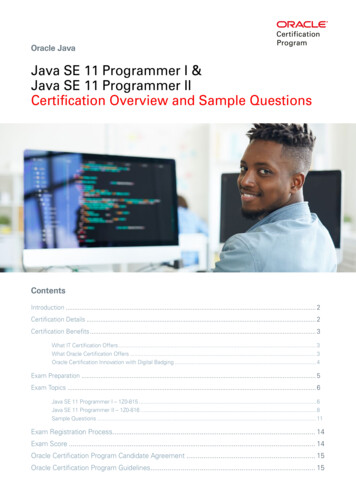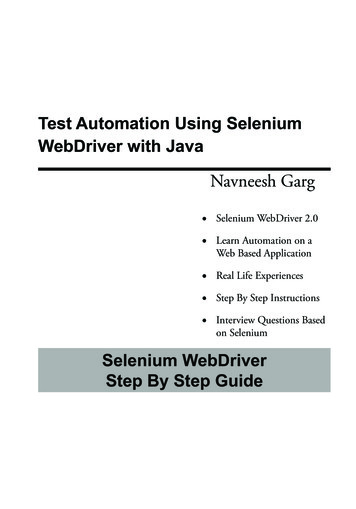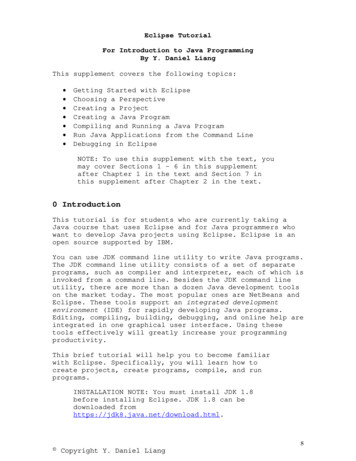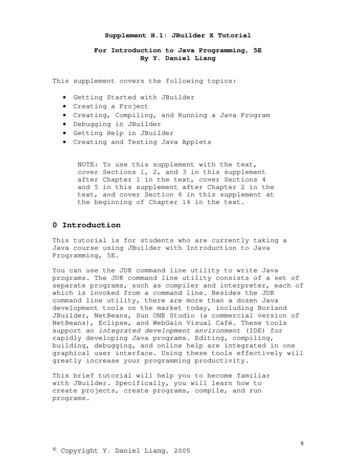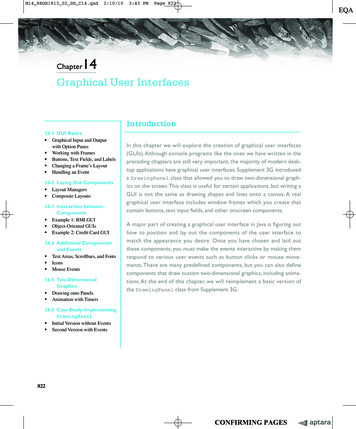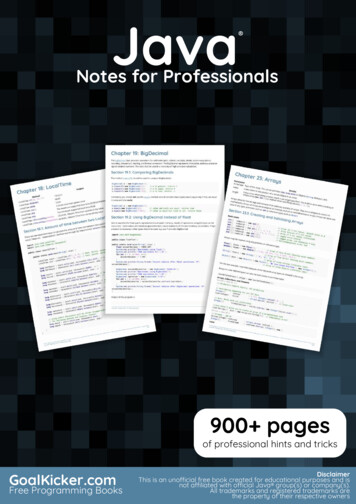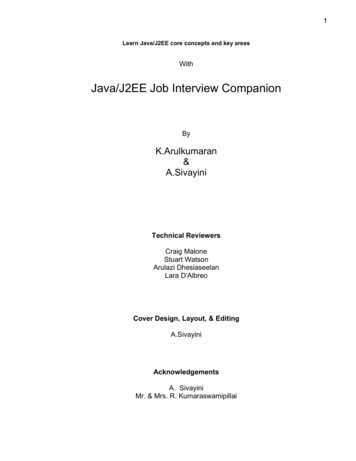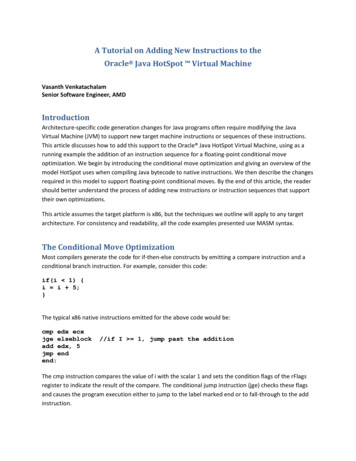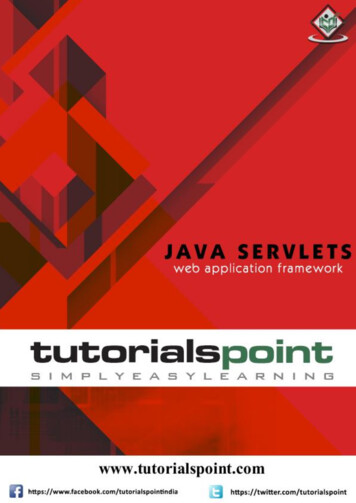
Transcription
Java ServletsAbout the TutorialServlets provide a component-based, platform-independent method for building Webbased applications, without the performance limitations of CGI programs. Servlets haveaccess to the entire family of Java APIs, including the JDBC API to access enterprisedatabases.This tutorial will teach you how to use Java Servlets to develop your web basedapplications in simple and easy steps.AudienceThis tutorial is designed for Java programmers with a need to understand the JavaServlets framework and its APIs. After completing this tutorial you will find yourself at amoderate level of expertise in using Java Servlets from where you can take yourself tonext levels.PrerequisitesWe assume you have good understanding of the Java programming language. It will begreat if you have a basic understanding of web application and how internet works.Copyright & Disclaimer Copyright 2015 by Tutorials Point (I) Pvt. Ltd.All the content and graphics published in this e-book are the property of Tutorials Point(I) Pvt. Ltd. The user of this e-book is prohibited to reuse, retain, copy, distribute orrepublish any contents or a part of the contents of this e-book in any manner withoutwritten consent of the publisher.We strive to update the contents of our website and tutorials as timely and as preciselyas possible, however, the contents may contain inaccuracies or errors. Tutorials Point (I)Pvt. Ltd. provides no guarantee regarding the accuracy, timeliness, or completeness ofour website or its contents including this tutorial. If you discover any errors on ourwebsite or in this tutorial, please notify us at contact@tutorialspoint.comi
Java ServletsTable of ContentsAbout the Tutorial . iAudience . iPrerequisites . iTable of Content . ii1.SERVLETS – OVERVIEW . 1Servlets Tasks . 2Servlets Packages . 2What is Next? . 22.SERVLETS – ENVIRONMENT SETUP . 3Setting up Java Development Kit . 3Setting up Web Server: Tomcat . 3Setting Up the CLASSPATH . 53.SERVLETS – LIFE CYCLE . 7The init() Method . 7The service() Method. 7The doGet() Method . 8The doPost() Method. 8The destroy() Method. 8Architecture Diagram . 94.SERVLETS – EXAMPLES . 10Sample Code. 10Compiling a Servlet . 11Servlet Deployment . 11ii
Java Servlets5.SERVLETS – FORM DATA . 13GET Method . 13POST Method . 13Reading Form Data using Servlet . 13GET Method Example using URL . 14GET Method Example Using Form . 16POST Method Example Using Form . 16Passing Checkbox Data to Servlet Program . 18Reading All Form Parameters . 206.SERVLETS – CLIENT HTTP REQUEST . 24Methods to read HTTP Header . 25HTTP Header Request Example . 277.SERVLETS – SERVER HTTP RESPONSE . 30Methods to Set HTTP Response Header . 32HTTP Header Response – Example . 338.SERVLETS – HTTP STATUS CODES . 36Methods to Set HTTP Status Code . 39HTTP Status Code Example . 399.SERVLETS – WRITING FILTERS . 41Servlet Filter Methods . 41Servlet Filter – Example . 42Servlet Filter Mapping in Web.xml . 43Using Multiple Filters. 43Filters Application Order . 44iii
Java Servlets10.SERVLETS – EXCEPTION HANDLING . 46web.xml Configuration . 46Request Attributes – Errors/Exceptions . 47Error Handler Servlet – Example . 4811.SERVLETS – COOKIES HANDLING . 52The Anatomy of a Cookie. 52Servlet Cookies Methods . 53Setting Cookies with Servlet . 54Reading Cookies with Servlet . 56Delete Cookies with Servlet . 5812.SERVLETS – SESSION TRACKING . 61Cookies . 61Hidden Form Fields . 61URL Rewriting . 61The HttpSession Object . 62Session Tracking Example . 63Deleting Session Data . 6613.SERVLETS – DATABASE ACCESS . 68Create Table . 68Create Data Records . 69Accessing a Database. 6914.SERVLETS – FILE UPLOADING . 73Creating a File Upload Form . 73Writing Backend Servlet . 74Compile and Running Servlet . 78iv
Java Servlets15.SERVLET – HANDLING DATE . 79Getting Current Date & Time . 80Date Comparison . 81Date Formatting using SimpleDateFormat . 81Simple DateFormat Format Codes . 8216.SERVLETS – PAGE REDIRECTION . 8417.SERVLETS – HITS COUNTER . 86Hit Counter for a Web Page . 8618.SERVLETS – AUTO PAGE REFRESH . 91Auto Page Refresh Example . 9119.SERVLETS – SENDING EMAIL . 94Send a Simple Email . 94Send an HTML Email . 97Send Attachment in Email . 99User Authentication Part . 10220.SERVLETS – PACKAGING. 103Creating Servlets in Packages . 103Compiling Servlets in Packages . 104Packaged Servlet Deployment . 10521.SERVLETS – DEBUGGING . 106System.out.println() . 106Message Logging . 106Using JDB Debugger . 107Using Comments . 108Client and Server Headers . 108v
Java ServletsImportant Debugging Tips . 10822.SERVLETS – INTERNATIONALIZATION . 110Detecting Locale . 110Languages Setting . 112Locale Specific Dates . 113Locale Specific Currency . 114Locale Specific Percentage . 11523.SERVLET – ANNOTATIONS . 117@WebServlet . 118@WebInitParam . 119@Webfilter . 121vi
Servlets – OverviewJava ServletsWhat are Servlets?Java Servlets are programs that run on a Web or Application server and act as a middlelayer between a requests coming from a Web browser or other HTTP client anddatabases or applications on the HTTP server.Using Servlets, you can collect input from users through web page forms, presentrecords from a database or another source, and create web pages dynamically.Java Servlets often serve the same purpose as programs implemented using theCommon Gateway Interface (CGI). But Servlets offer several advantages in comparisonwith the CGI. Performance is significantly better. Servlets execute within the address space of a Web server. It is not necessary tocreate a separate process to handle each client request. Servlets are platform-independent because they are written in Java. Java security manager on the server enforces a set of restrictions to protect theresources on a server machine. So servlets are trusted. The full functionality of the Java class libraries is available to a servlet. It cancommunicate with applets, databases, or other software via the sockets and RMImechanisms that you have seen already.Servlets ArchitectureThe following diagram shows the position of Servlets in a Web Application.1
Java ServletsServlets TasksServlets perform the following major tasks: Read the explicit data sent by the clients (browsers). This includes an HTML formon a Web page or it could also come from an applet or a custom HTTP clientprogram. Read the implicit HTTP request data sent by the clients (browsers). This includescookies, media types and compression schemes the browser understands, and soforth. Process the data and generate the results. This process may require talking to adatabase, executing an RMI or CORBA call, invoking a Web service, or computingthe response directly. Send the explicit data (i.e., the document) to the clients (browsers). Thisdocument can be sent in a variety of formats, including text (HTML or XML),binary (GIF images), Excel, etc. Send the implicit HTTP response to the clients (browsers). This includes tellingthe browsers or other clients what type of document is being returned (e.g.,HTML), setting cookies and caching parameters, and other such tasks.Servlets PackagesJava Servlets are Java classes run by a web server that has an interpreter that supportsthe Java Servlet specification.Servlets can be created using the javax.servlet and javax.servlet.http packages,which are a standard part of the Java's enterprise edition, an expanded version of theJava class library that supports large-scale development projects.These classes implement the Java Servlet and JSP specifications. At the time of writingthis tutorial, the versions are Java Servlet 2.5 and JSP 2.1.Java servlets have been created and compiled just like any other Java class. After youinstall the servlet packages and add them to your computer's Classpath, you can compileservlets with the JDK's Java compiler or any other current compiler.What is Next?I would take you step by step to set up your environment to start with Servlets. Sofasten your belt for a nice drive with Servlets. I'm sure you are going to enjoy thistutorial very much.2
Java ServletsServlets – Environment SetupA development environment is where you would develop your Servlet, test them andfinally run them.Like any other Java program, you need to compile a servlet by using the Java compilerjavac and after compilation the servlet application, it would be deployed in a configuredenvironment to test and run.This development environment setup involves the following steps:Setting up Java Development KitThis step involves downloading an implementation of the Java Software Development Kit(SDK) and setting up PATH environment variable appropriately.You can download SDK from Oracle's Java site: Java SE Downloads.Once you download your Java implementation, follow the given instructions to install andconfigure the setup. Finally set PATH and JAVA HOME environment variables to refer tothe directory that contains java and javac, typically java install dir/bin andjava install dir respectively.If you are running Windows and installed the SDK in C:\jdk1.8.0 65, you would put thefollowing line in your C:\autoexec.bat file.set PATH C:\jdk1.8.0 65\bin;%PATH%set JAVA HOME C:\jdk1.8.0 65Alternatively, on Windows NT/2000/XP, you could also right-click on My Computer, selectProperties, then Advanced, then Environment Variables. Then, you would update thePATH value and press the OK button.On Unix (Solaris, Linux, etc.), if the SDK is installed in /usr/local/jdk1.8.0 65 and youuse the C shell, you would put the following into your .cshrc file.setenv PATH /usr/local/jdk1.8.0 65/bin: PATHsetenv JAVA HOME /usr/local/jdk1.8.0 65Alternatively, if you use an Integrated Development Environment (IDE) like BorlandJBuilder, Eclipse, IntelliJ IDEA, or Sun ONE Studio, compile and run a simple program toconfirm that the IDE knows where you installed Java.Setting up Web Server: TomcatA number of Web Servers that support servlets are available in the market. Some webservers are freely downloadable and Tomcat is one of them.3
Java ServletsApache Tomcat is an open source software implementation of the Java Servlet and JavaServer Pages technologies and can act as a standalone server for testing servlets andcan be integrated with the Apache Web Server. Here are the steps to setup Tomcat onyour machine: Download latest version of Tomcat from http://tomcat.apache.org/. Once you downloaded the installation, unpack the binary distribution into aconvenient location. For example in C:\apache-tomcat-8.0.28 on windows, or/usr/local/apache-tomcat-8.0.289 on Linux/Unix and create CATALINA HOMEenvironment variable pointing to these locations.Tomcat can be started by executing the following commands on windows machine:%CATALINA \startup.batTomcat can be started by executing the following commands on Unix (Solaris, Linux,etc.) machine: CATALINA 28/bin/startup.shAfter startup, the default web applications included with Tomcat will be available byvisiting http://localhost:8080/. If everything is fine then it should display followingresult:4
Java ServletsFurther information about configuring and running Tomcat can be found in bsite:http://tomcat.apache.orgTomcat can be stopped by executing the following commands on windows machine:C:\apache-tomcat-8.0.28\bin\shutdownTomcat can be stopped by executing the following commands on Unix (Solaris, Linux,etc.) wn.shSetting Up the CLASSPATHSince servlets are not part of the Java Platform, Standard Edition, you must identify theservlet classes to the compiler.If you are running Windows, you need to put the following lines in your C:\autoexec.batfile.set CATALINA C:\apache-tomcat-8.0.28set CLASSPATH lternatively, on Windows NT/2000/XP, you could go to My Computer - Properties - Advanced - Environment Variables. Then, you would update the CLASSPATH value andpress the OK button.On Unix (Solaris, Linux, etc.), if you are using the C shell, you would put the followinglines into your .cshrc file.setenv CATALINA /usr/local/apache-tomcat-8.0.285
Java Servletssetenv CLASSPATH CATALINA/common/lib/servlet-api.jar: CLASSPATHNOTE: Assuming that your development directory is C:\ServletDevel (Windows) or/usr/ServletDevel (Unix) then you would need to add these directories as well inCLASSPATH in similar way as you have added above.6
Servlets – Life CycleJava ServletsA servlet life cycle can be defined as the entire process from its creation till thedestruction. The following are the paths followed by a servlet The servlet is initialized by calling the init () method. The servlet calls service() method to process a client's request. The servlet is terminated by calling the destroy() method. Finally, servlet is garbage collected by the garbage collector of the JVM.Now let us discuss the life cycle methods in detail.The init() MethodThe init method is called only once. It is called only when the servlet is created, and notcalled for any user requests afterwards. So, it is used for one-time initializations, just aswith the init method of applets.The servlet is normally created when a user first invokes a URL corresponding to theservlet, but you can also specify that the servlet be loaded when the server is firststarted.When a user invokes a servlet, a single instance of each servlet gets created, with eachuser request resulting in a new thread that is handed off to doGet or doPost asappropriate. The init() method simply creates or loads some data that will be usedthroughout the life of the servlet.The init method definition looks like this:public void init() throws ServletException {// Initialization code.}The service() MethodThe service() method is the main method to perform the actual task. The servletcontainer (i.e. web server) calls the service() method to handle requests coming fromthe client( browsers) and to write the formatted response back to the client.Each time the server receives a request for a servlet, the server spawns a new threadand calls service. The service() method checks the HTTP request type (GET, POST, PUT,DELETE, etc.) and calls doGet, doPost, doPut, doDelete, etc. methods as appropriate.7
Java ServletsHere is the signature of this method:public void service(ServletRequest request,ServletResponse response)throws ServletException, IOException{}The service () method is called by the container and service method invokes doGe,doPost, doPut, doDelete, etc. methods as appropriate. So you have nothing to do withservice() method but you override either doGet() or doPost() depending on what type ofrequest you receive from the client.The doGet() and doPost() are most frequently used methods with in each servicerequest. Here is the signature of these two methods.The doGet() MethodA GET request results from a normal request for a URL or from an HTML form that hasno METHOD specified and it should be handled by doGet() method.public void doGet(HttpServletRequest request,HttpServletResponse response)throws ServletException, IOException {// Servlet code}The doPost() MethodA POST request results from an HTML form that specifically lists POST as the METHODand it should be handled by doPost() method.public void doPost(HttpServletRequest request,HttpServletResponse response)throws ServletException, IOException {// Servlet code}The destroy() MethodThe destroy() method is called only once at the end of the life cycle of a servlet. Thismethod gives your servlet a chance to close database connections, halt backgroundthreads, write cookie lists or hit counts to disk, and perform other such cleanupactivities.8
Java ServletsAfter the destroy() method is called, the servlet object is marked for garbage collection.The destroy method definition looks like this:public void destroy() {// Finalization code.}Architecture DiagramThe following figure depicts a typical servlet life-cycle scenario. First the HTTP requests coming to the server are delegated to the servletcontainer. The servlet container loads the servlet before invoking the service() method. Then the servlet container handles multiple requests by spawning multiplethreads, each thread executing the service() method of a single instance of theservlet.9
Java ServletsEnd of ebook previewIf you liked what you saw Buy it from our store @ https://store.tutorialspoint.com10
Java class library that supports large-scale development projects. These classes implement the Java Servlet and JSP specifications. At the time of writing this tutorial, the versions are Java Servlet 2.5 and JSP 2.
